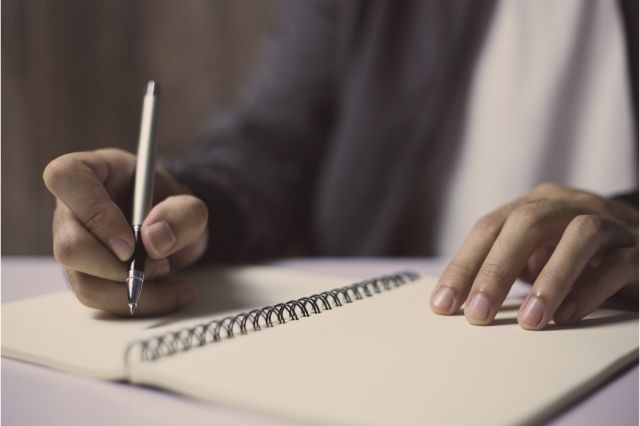What Is Line Editing and How Can It Improve Your Writing?

Looking for ways to polish your writing? Line editing can improve the flow, clarity, and effectiveness of your draft. It is equally useful in writing academic essays and creative pieces because a good line edit can strengthen your writing voice and help connect with the reader. In this article, we’ll discuss what line editing is and how you can use it to make your writing sharp and clear.
What Is Line Editing?
Line editing is a practice that allows you to increase the effectiveness of your writing at the sentence and paragraph level. As the name suggests, it involves editing the text line-by-line, paying attention to every word. Although you might correct some spelling or punctuation errors while line editing, it is not the main focus of the practice. Line editing targets syntax, style, flow, and word choice. Its goal is to evaluate how these aspects contribute to the meaning of the piece and make the necessary changes to make your writing eloquent.
The line editing stage takes place once you’ve finished and revised your first draft. Note that line editing and revision are two different processes that pursue different aims. Revisions improve the structure of your story, while line edits are meant to help you find the most effective language to convey your message.
Self-editing, however, can be tricky. Sometimes we are blind to our own mistakes unless we take enough time to detach ourselves from the text. If it’s not an option, you can ask a friend to edit your work or find a do my paper for me service to get professional writing and editing help. This allows you to get a fresh perspective on your writing and make sure your edit is effective.
5 Benefits of Line Editing
Line editing is a challenging yet extremely rewarding practice that allows you to hone your voice, style, and choices in writing. Here are five ways in which line editing can strengthen your draft.
1. Better Word Choice
When you edit your piece line by line, you can pay attention to every detail. If a word sounds unnatural or out of place, you can use a thesaurus to find a more fitting option. Precise word choice allows you to communicate the intended meaning and evoke a response in your readers.
2. Consistency
If you’re working on a large paper or creative piece, it’s easy to get distracted and let a few inconsistencies slip in. These can be plot hopes, missing explanations, or logical errors. Line editing helps you double-check all facts and fix the gaps in meaning. A good writer will never leave their paper unedited. If you ask an expert to write your texts, you can be sure that they are free from errors and inconsistent paragraphs. Thus, nothing will confuse your readers.
3. Perfect Tone
The tone is a crucial aspect of writing. When working on academic papers, you want to stick to a formal tone. In contrast, personal letters can be informal and more expressive. An assertive tone establishes authority, while an encouraging tone serves to show support. You should identify the purpose of your writing and keep it in mind while editing. It will help you adjust language use according to the preferred tone.
4. Conciseness
Less is more is often a key to success. Line editors cut sentences or entire paragraphs if they affect the dynamics of the piece by being repetitive or irrelevant. Remember that the goal of line editing is to make sure that each element of your piece contributes to its meaning. If it doesn’t, cut it with no regrets.
5. Improved Writing Skills
Line editing is an effective way to learn how to write better and evoke the intended reactions in the readers. It’s also critical to developing your writing voice. Line editing gives you insights into your style with its strong and weak points, which helps you fix problem areas and become a better writer with each new draft you edit.
Dos and Don’ts of Line Editing
Here are some essential line editing tips that will guide you through the process.
Do
- Put your piece aside for a few days to come back to it with fresh eyes.
- Check the flow of the piece and make sure it’s smooth and fluid.
- Eliminate redundancies and unnecessary digressions.
- Get rid of clichés.
- Scan the text for point of view errors and inconsistencies.
- Improve transitions between ideas.
- Avoid weak verbs, adjectives, and adverbs because they lessen the impact of your writing.
- Identify and fix plot holes.
- Improve syntax and word choice to match the tone of the piece.
Don’t
- Rely on a thesaurus too much. While moderate use improves your word choice, going overboard may affect clarity and style.
- Alter your authentic writing voice and stylistic choices. You don’t want to lose the aspects that make your writing unique.
- Be afraid to ask for professional assistance with editing if you feel like you can’t manage the task on your own.
- Overexplain information. While sometimes some extra detail can improve clarity, explaining your point to an excessive degree destroys the dynamics and flow of your writing.
To Sum Up
Line editing is an art that allows you to find the right words to tell your story. In a nutshell, it makes your writing sing! Line editing allows you to make the most out of every line and make sure you convey the right atmosphere, cut unnecessary information, and improve language use. Try this practice if you want to deliver quality creative content and connect with your readers on a deeper level.





